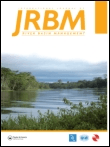
INTERNATIONAL JOURNAL OF RIVER BASIN MANAGEMENT
Scope & Guideline
Advancing sustainable solutions for river basin management.
Introduction
Aims and Scopes
- Hydrological Modeling and Analysis:
Research that employs various hydrological models to simulate and predict water flow, sediment transport, and water quality in river basins. - Geospatial Technology Applications:
Utilization of Geographic Information Systems (GIS) and remote sensing technologies for mapping, monitoring, and analyzing river basin characteristics and changes. - Environmental Impact Assessments:
Studies focused on evaluating the ecological and environmental impacts of human activities, such as land use changes, dam constructions, and pollution in river basins. - Socioeconomic Studies and Policy Analysis:
Research that examines the social and economic dimensions of river basin management, including community engagement, governance, and sustainability practices. - Climate Change Impacts:
Investigations into how climate change affects hydrological cycles, water resources, and ecosystem services within river basins. - Flood and Drought Risk Management:
Research addressing strategies and methodologies for managing flood and drought risks, including modeling, assessments, and policy frameworks.
Trending and Emerging
- Integrated Water Resource Management (IWRM):
There is a significant increase in research focused on IWRM approaches that consider the interconnectedness of water, land, and ecosystems in managing river basins. - Climate Change Adaptation Strategies:
Emerging studies are increasingly addressing how river basins can adapt to the impacts of climate change, focusing on resilience-building and sustainable practices. - Public Participation and Governance:
Research exploring the role of community involvement and governance structures in river basin management is on the rise, indicating a shift towards more inclusive management practices. - Water Quality and Pollution Control:
There is a growing emphasis on assessing and improving water quality, with studies focusing on pollution sources, mitigation strategies, and health risk assessments. - Ecosystem Services Valuation:
Emerging research is focusing on the valuation of ecosystem services provided by river basins, highlighting their importance for sustainable management and policy-making.
Declining or Waning
- Traditional Hydraulic Engineering:
There is a noticeable decrease in the focus on conventional hydraulic engineering methods, as the journal shifts towards more integrated and interdisciplinary approaches to river basin management. - Single-Factor Studies:
Research that solely examines one aspect of river basin management, such as only hydrology or only ecology, is becoming less common as the emphasis on integrated studies grows. - Historical Case Studies:
While historical analyses still hold value, there is a waning interest in purely historical case studies without contemporary relevance or application to current river management issues.
Similar Journals
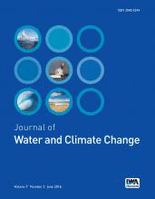
Journal of Water and Climate Change
Exploring the Nexus of Water Resources and Climate DynamicsJournal of Water and Climate Change is a premier open-access journal published by IWA Publishing, dedicated to advancing the understanding of the interplay between water resources and climate change. With an ISSN of 2040-2244 and an E-ISSN of 2408-9354, this journal has established itself as a crucial platform for interdisciplinary research, publishing high-quality articles that address the challenges posed by climate variability on water systems globally. Since achieving open access status in 2021, the journal has fostered wider dissemination of knowledge among its audience, featuring works that span pivotal topics in Atmospheric Science, Global and Planetary Change, and Water Management. Notably ranked within the top quartiles in several relevant categories as of 2023, it occupies a vital position in the academic community, offering insights that are essential for policymakers, environmental scientists, and researchers striving to create sustainable solutions for water and climate challenges. Its commitment to excellence is reflected in its strong Scopus rankings, standing at the 66th percentile in Water Science and Technology and 65th percentile in Management, Monitoring, Policy, and Law. Located in the United Kingdom, this journal not only serves as a repository of cutting-edge research from 2010 to 2024 but also engages a diverse readership passionate about promoting sustainable water management practices.

COASTAL MANAGEMENT
Advancing sustainable solutions for coastal ecosystems.COASTAL MANAGEMENT is a distinguished journal published by Taylor & Francis Inc, specializing in the interdisciplinary field of environmental science with a focus on coastal ecosystems. Since its inception in 1987, this journal has provided a critical platform for researchers and practitioners to disseminate innovative studies and practical solutions related to coastal management challenges. With an impressive Q2 ranking in both Environmental Chemistry and Environmental Science categories, it is recognized for its significant contributions to the field, evidenced by its Scopus ranking of #61/233 in General Environmental Science and #60/147 in Environmental Chemistry. Although open access options are not available, the journal maintains a broad readership within the academic community through its comprehensive exploration of coastal issues. With a commitment to advancing knowledge and fostering collaboration among experts, COASTAL MANAGEMENT plays a pivotal role in shaping sustainable practices and policies essential for the conservation and stewardship of our vital coastal environments.
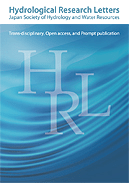
Hydrological Research Letters
Empowering Research: Navigating the Waters of DiscoveryHydrological Research Letters (ISSN: 1882-3416) is a distinguished peer-reviewed journal published by JSHWR, JAGH, JAHS, JSPH in Japan. Established with open access since 2007, this journal serves as a critical platform for the dissemination of innovative research in the field of hydrology, water science, and technology. With an increasing impact factor, currently positioned in the Q3 quartile for both Earth and Planetary Sciences and Water Science and Technology, it attracts a diverse readership keen to stay abreast of groundbreaking findings that shape water management and environmental policy. Researchers, professionals, and students alike will find this publication an invaluable resource for enhancing their understanding of hydrological processes and their implications. The journal is committed to fostering open academic dialogue and encouraging high-quality contributions during its converging years from 2015 to 2024. For more information, authors and readers can access the journal at its address, C/O INT ACAD PRINTING CO, LTD, Shinjuku-ku, Tokyo, Japan.
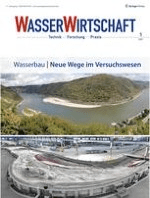
WasserWirtschaft
Advancing water science for a sustainable future.WasserWirtschaft is a renowned academic journal dedicated to the critical field of water science and technology. Published by SPRINGER VIEWEG-SPRINGER FACHMEDIEN WIESBADEN GMBH, this journal has been a vital resource for researchers, professionals, and students since its inception in 1973, covering an extensive range of topics pertinent to water management, engineering, and environmental sustainability. Although it is currently ranked in the Q4 category of the Water Science and Technology category as per the 2023 Scopus metrics, with a ranking of #246 out of 261, the journal is committed to enhancing the discourse surrounding water resource management through high-quality, peer-reviewed articles. The journal does not operate on an Open Access basis, ensuring that its content is curated and accessible to subscribers while promoting rigorous academic standards. With its historical significance and focus on contemporary water-related challenges, WasserWirtschaft remains an essential publication for stakeholders aiming to advance the science and technology of water resources in a rapidly changing world.

LHB-Hydroscience Journal
Pioneering Research for a Water-Secure FutureLHB-Hydroscience Journal, published by Routledge Journals, Taylor & Francis Ltd in the United Kingdom, stands as a significant platform in the realm of Water Science and Technology. Since its inception in 2021, this open-access journal has been dedicated to disseminating high-quality research that addresses the critical challenges faced in hydroscience, aiming particularly at fostering innovative solutions for sustainable water management. With an impressive E-ISSN of 2767-8490, it offers researchers, professionals, and students the opportunity to access cutting-edge findings without any paywall, thereby promoting wider dissemination and engagement within the academic community. Although it currently holds a Q4 quartile ranking and ranks #208 out of 261 in the Environmental Science category, the journal aspires to elevate its scholarly impact through rigorous peer-reviewed articles that contribute to the field from 2021 to 2024. As recognition of its growing significance, LHB-Hydroscience Journal invites contributions that explore the multidimensional aspects of water science—from interdisciplinary methodologies to real-world applications—catering to an audience eager to push the boundaries of current knowledge.

Hydrologie und Wasserbewirtschaftung
Advancing water science for a sustainable future.Hydrologie und Wasserbewirtschaftung, published by the BUNDESANSTALT GEWASSERKUNDE-BFG, stands as a vital open access journal in the field of hydrology and water management since its inception in 1999. Based in Germany, this journal aims to disseminate high-quality research related to water resources, environmental sustainability, and innovative management strategies. Though it has a Q4 ranking in Water Science and Technology for 2023, and holds a Scopus rank of 113 out of 225, the journal provides an essential platform for researchers, professionals, and students interested in advancing their understanding of water science. With coverage spanning from 1999 to 2018 and a seamless move to an open access model, Hydrologie und Wasserbewirtschaftung remains committed to contributing to the ongoing dialogue around critical water issues. Researchers looking to publish their findings or stay abreast of developments in water science will find this journal indispensable.

Journal of Hydrology X
Innovating Hydrology: Bridging Research and PracticeJournal of Hydrology X, a premier publication in the field of water science and technology, is published by ELSEVIER from the Netherlands. Since transitioning to Open Access in 2018, this journal has provided researchers, professionals, and students unrestricted access to vital research findings and advancements in hydrology. With an impressive Q1 category ranking in 2023, and a Scopus ranking of #41 out of 261 in Environmental Science, it stands at the forefront of water-related studies, showcasing high-quality, peer-reviewed articles that drive innovation and collaboration. The journal focuses on integrative approaches from 2019 to 2024, catering to a diverse audience eager to advance the understanding and management of freshwater resources globally. Its commitment to disseminating impactful research makes it an essential resource for anyone working in or studying this vital field.
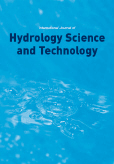
International Journal of Hydrology Science and Technology
Unlocking the Potential of Hydrological Science and TechnologyThe International Journal of Hydrology Science and Technology, published by InderScience Enterprises Ltd, is a distinguished platform dedicated to advancing knowledge in the field of hydrology, environmental engineering, and water science. With an ISSN of 2042-7808 and an E-ISSN of 2042-7816, this journal, established in 2011 and continuing through 2024, serves as an essential resource for researchers, professionals, and students alike. Despite being categorized in the Q3 quartile across multiple disciplines including Earth and Planetary Sciences, Environmental Engineering, Waste Management and Disposal, and Water Science and Technology, the journal maintains a reputation for contributing significant findings that impact both theory and practical applications in addressing hydrological challenges. Currently unavailable through Open Access options, the journal remains committed to disseminating valuable research that informs sustainable practices in water resource management. The editorial team encourages submissions that explore innovative strategies and methodologies while fostering interdisciplinary discussions, making this journal a pivotal player in shaping the future of hydrological science.
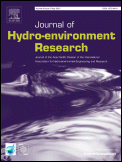
Journal of Hydro-environment Research
Bridging human activities and water resources through research.The Journal of Hydro-environment Research, published by Elsevier, serves as a leading platform for advancing knowledge in the fields of civil and structural engineering, environmental chemistry, and water science. With a robust impact factor reflecting its Q2 category ranking across various disciplines—including Environmental Engineering and Management, Monitoring, Policy and Law—it emphasizes high-quality research that addresses pressing environmental challenges. Embracing a global perspective, the journal explores interdisciplinary approaches to water and environmental management, thus empowering researchers and professionals to innovate and implement effective solutions. Since its inception in 2007, the journal has continually evolved, with its scope expanding into emerging areas pertinent to water science and technology. The journal is indexed in esteemed databases, ensuring wide dissemination and accessibility of published works, although it does not currently operate on an open access model. Addressing the intricate interplay between human activities and water resources, the Journal of Hydro-environment Research is quintessential for those dedicated to fostering sustainable practices and enhancing our understanding of hydro-environmental systems.

Earth Systems and Environment
Championing Research for a Resilient EnvironmentEarth Systems and Environment, published by Springer International Publishing AG, is a leading peer-reviewed journal dedicated to the multidisciplinary study of natural and anthropogenic processes that shape the Earth's systems. With an impressive impact factor and consistently ranked in the Q1 category across various fields, including Computers in Earth Sciences, Economic Geology, and Environmental Science, it stands as a premier platform for researchers and professionals seeking to address pressing environmental challenges. The journal covers a wide spectrum of topics, from geology to global change, and emphasizes innovative methodologies and interdisciplinary approaches to understand and manage Earth systems. As an essential resource for scholars and practitioners, Earth Systems and Environment commits to excellence and facilitates open dialogue on critical issues affecting our planet.